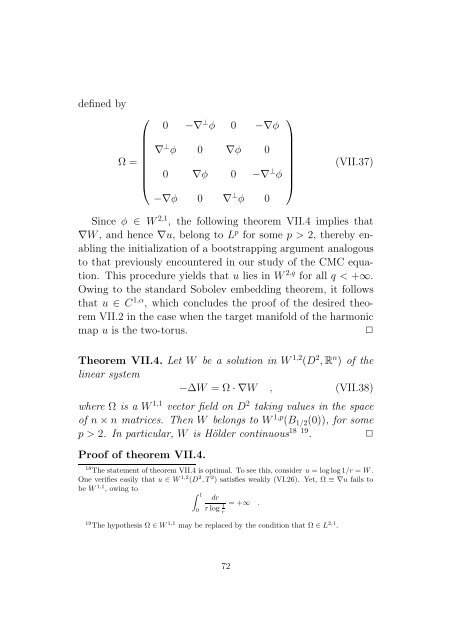Conformally Invariant Variational Problems. - SAM
Conformally Invariant Variational Problems. - SAM
Conformally Invariant Variational Problems. - SAM
Create successful ePaper yourself
Turn your PDF publications into a flip-book with our unique Google optimized e-Paper software.
defined by<br />
⎛<br />
Ω =<br />
⎜<br />
⎝<br />
0 −∇ ⊥ φ 0 −∇φ<br />
∇ ⊥ φ 0 ∇φ 0<br />
0 ∇φ 0 −∇ ⊥ φ<br />
−∇φ 0 ∇ ⊥ φ 0<br />
⎞<br />
⎟<br />
⎠<br />
(VII.37)<br />
Since φ ∈ W 2,1 , the following theorem VII.4 implies that<br />
∇W, and hence ∇u, belong to L p for some p > 2, thereby enabling<br />
the initialization of a bootstrapping argument analogous<br />
to that previously encountered in our study of the CMC equation.<br />
This procedure yields that u lies in W 2,q for all q < +∞.<br />
Owing to the standard Sobolev embedding theorem, it follows<br />
that u ∈ C 1,α , which concludes the proof of the desired theorem<br />
VII.2 in the case when the target manifold of the harmonic<br />
map u is the two-torus.<br />
✷<br />
Theorem VII.4. Let W be a solution in W 1,2 (D 2 ,R n ) of the<br />
linear system<br />
−∆W = Ω·∇W , (VII.38)<br />
where Ω is a W 1,1 vector field on D 2 taking values in the space<br />
of n×n matrices. Then W belongs to W 1,p (B 1/2 (0)), for some<br />
p > 2. In particular, W is Hölder continuous 18 19 . ✷<br />
Proof of theorem VII.4.<br />
18 The statement of theorem VII.4 is optimal. To see this, consider u = loglog1/r = W.<br />
One verifies easily that u ∈ W 1,2 (D 2 ,T 2 ) satisfies weakly (VI.26). Yet, Ω ≡ ∇u fails to<br />
be W 1,1 , owing to<br />
∫ 1<br />
dr<br />
0 rlog 1 = +∞ .<br />
r<br />
19 The hypothesis Ω ∈ W 1,1 may be replaced by the condition that Ω ∈ L 2,1 .<br />
72
















